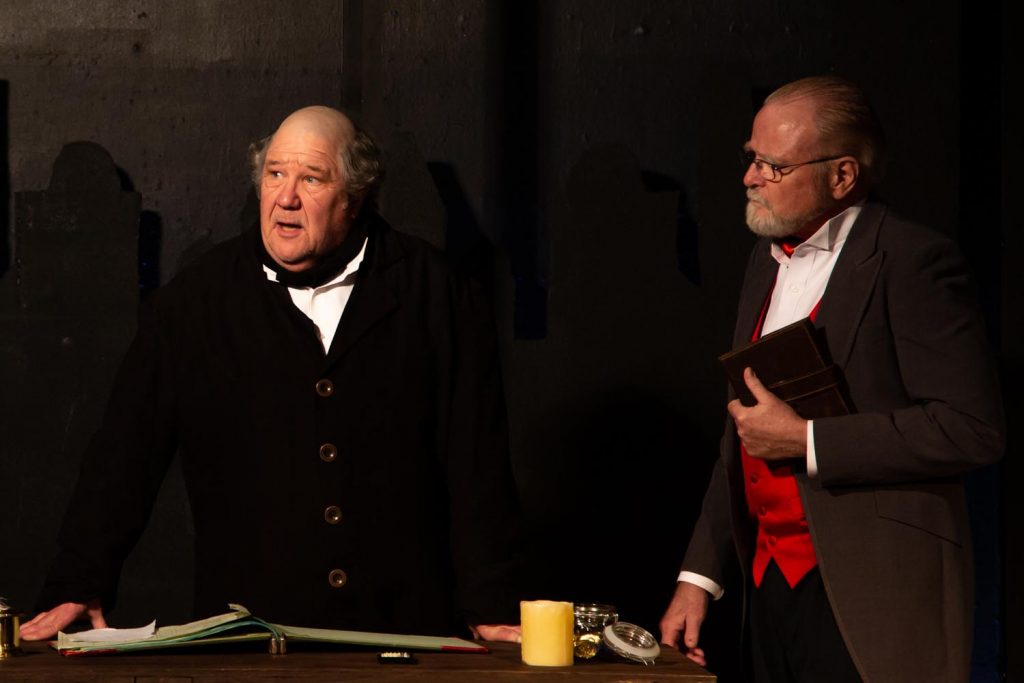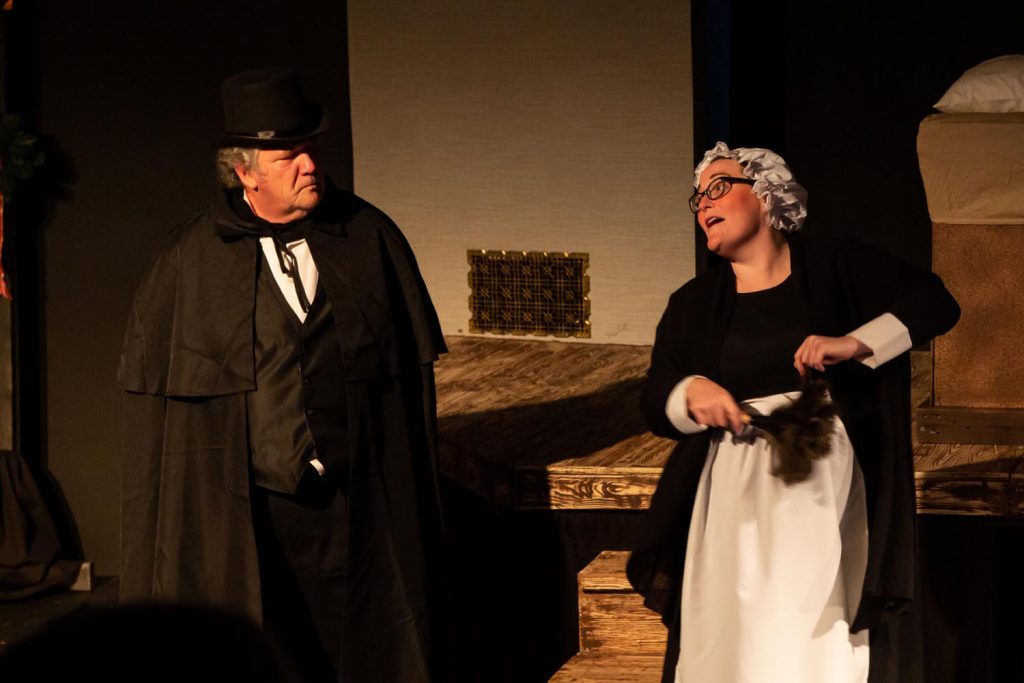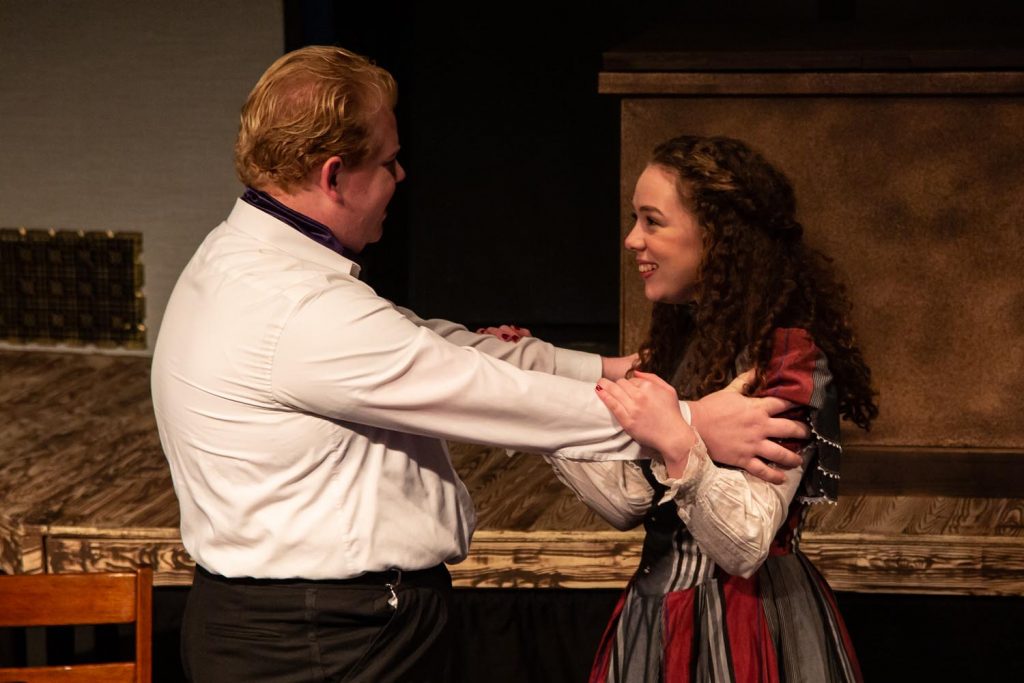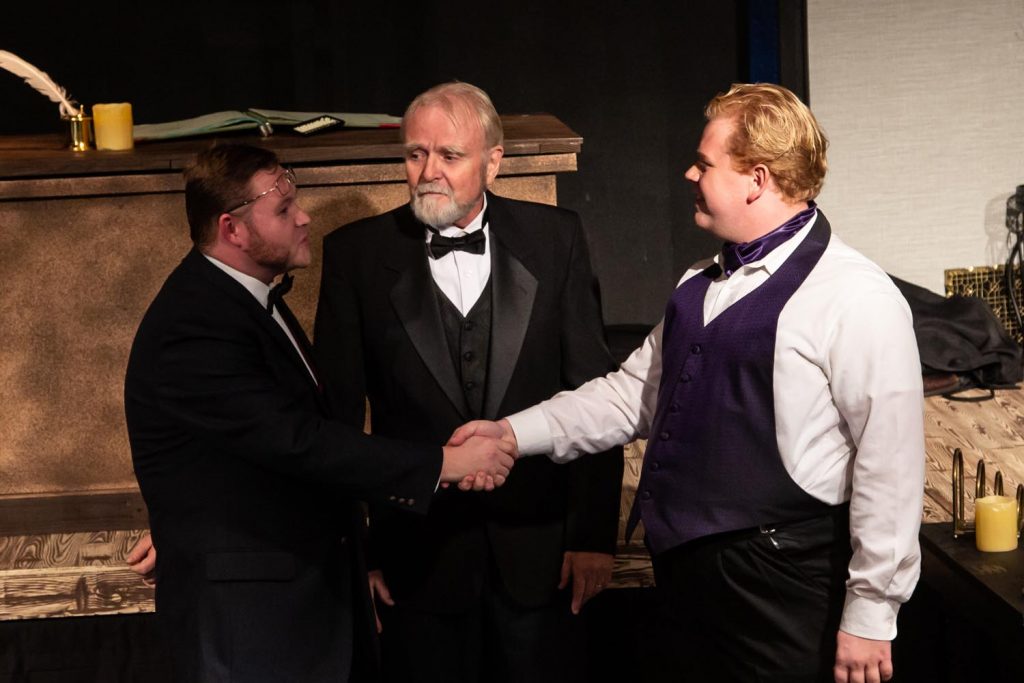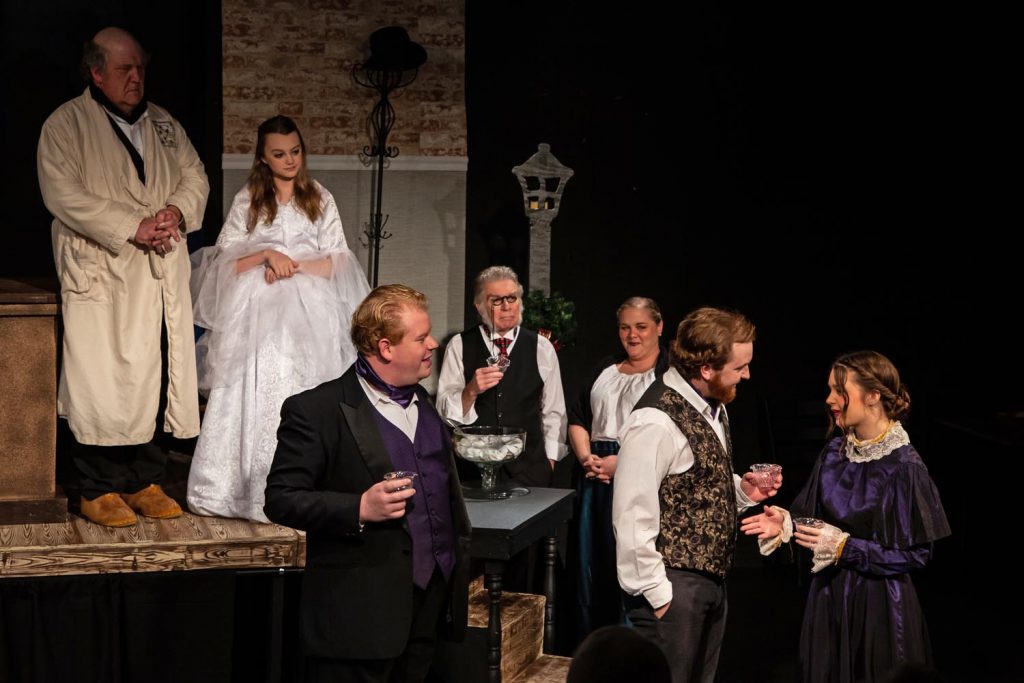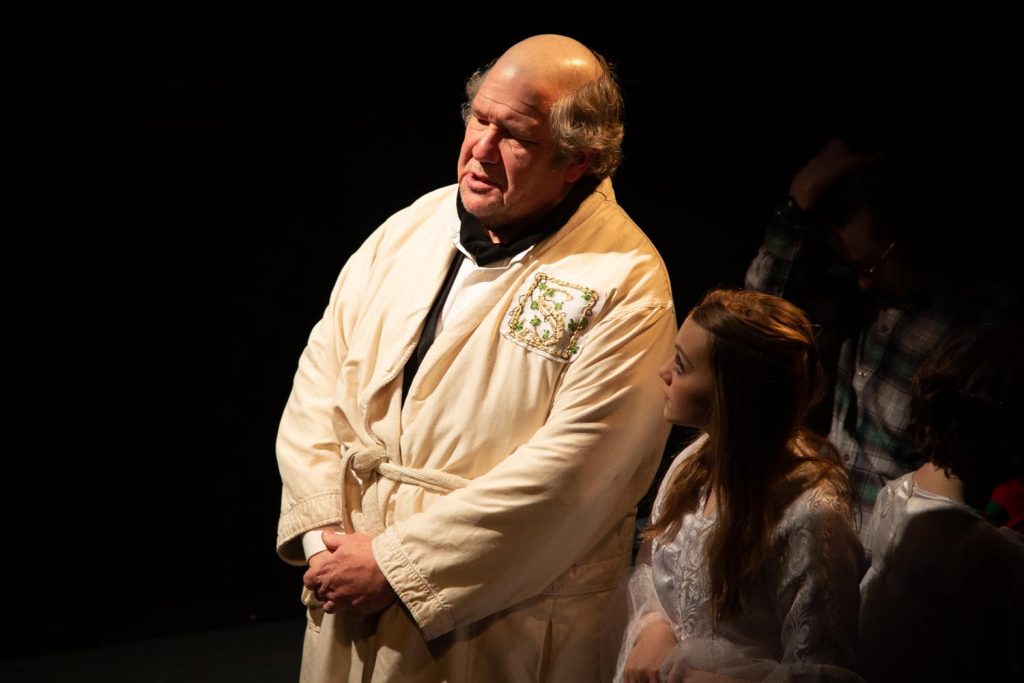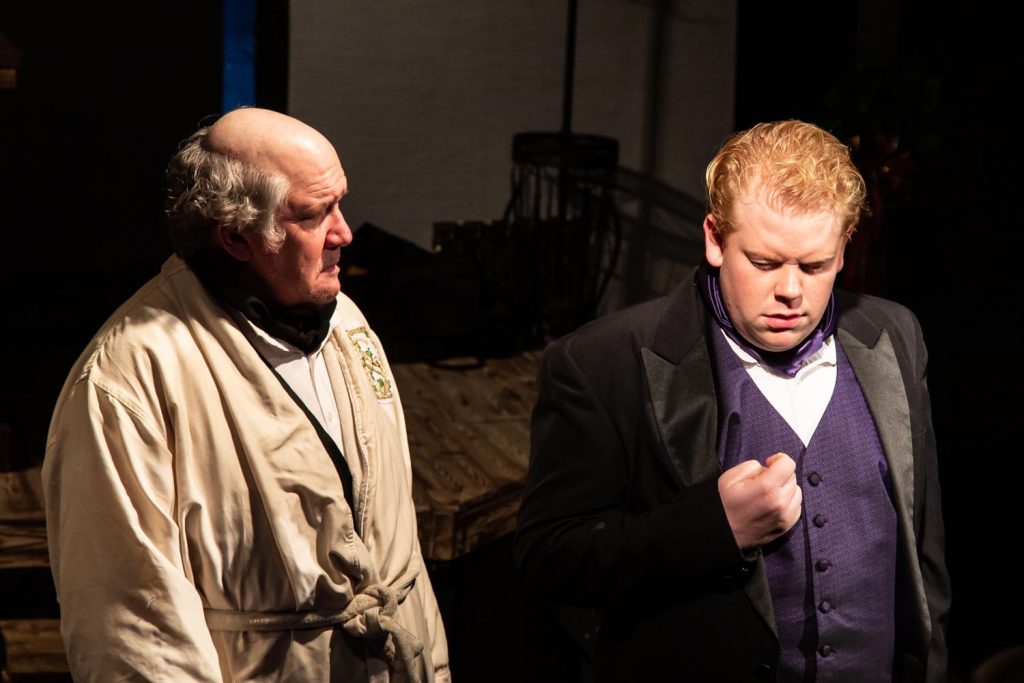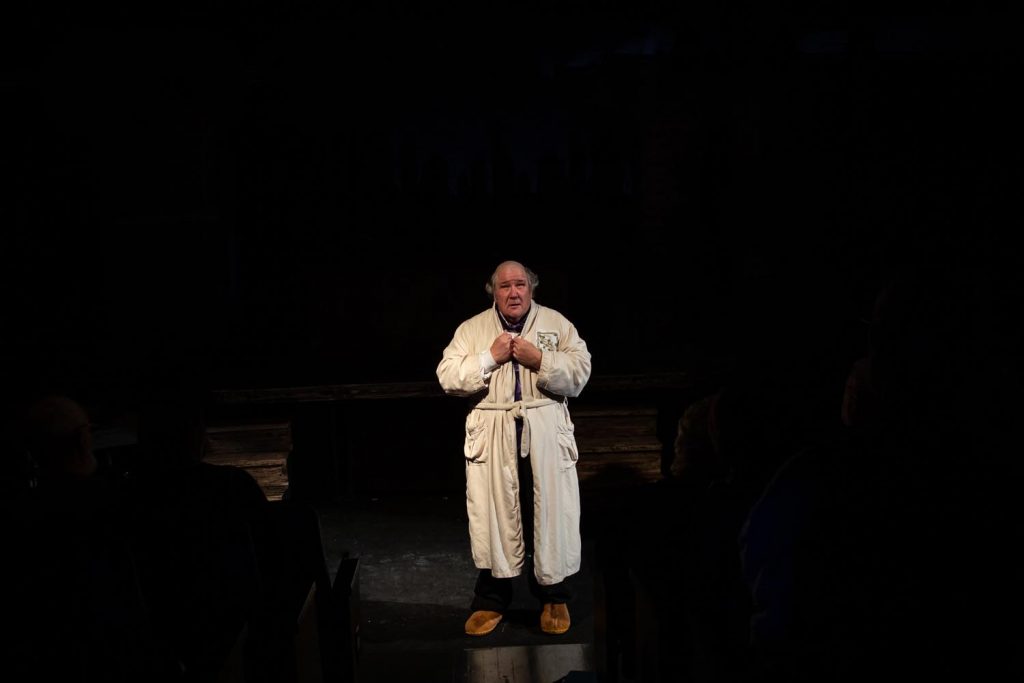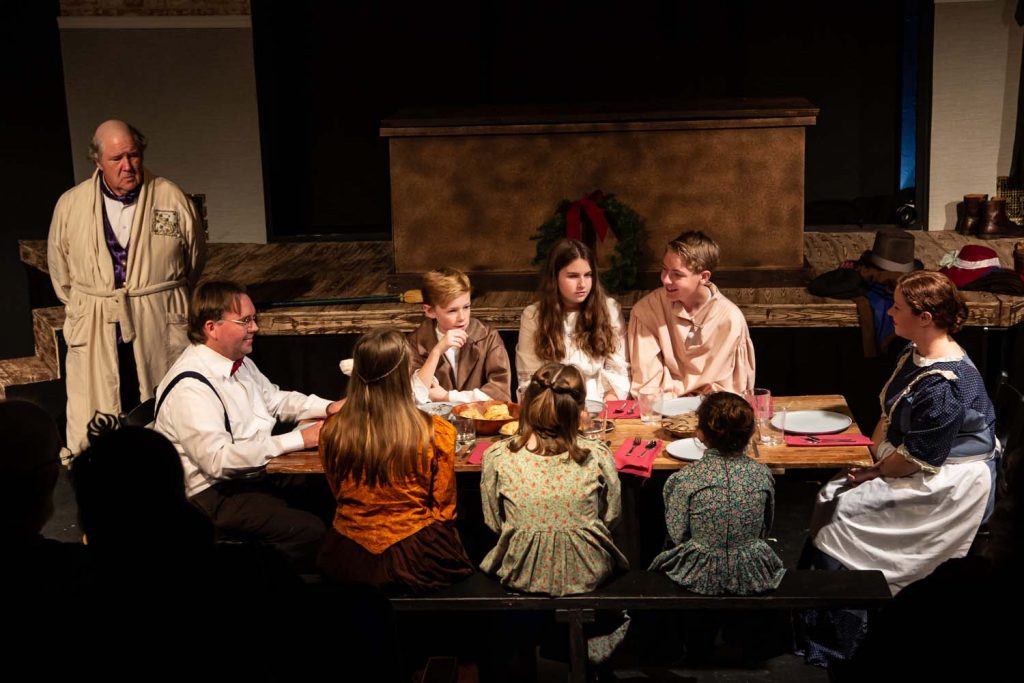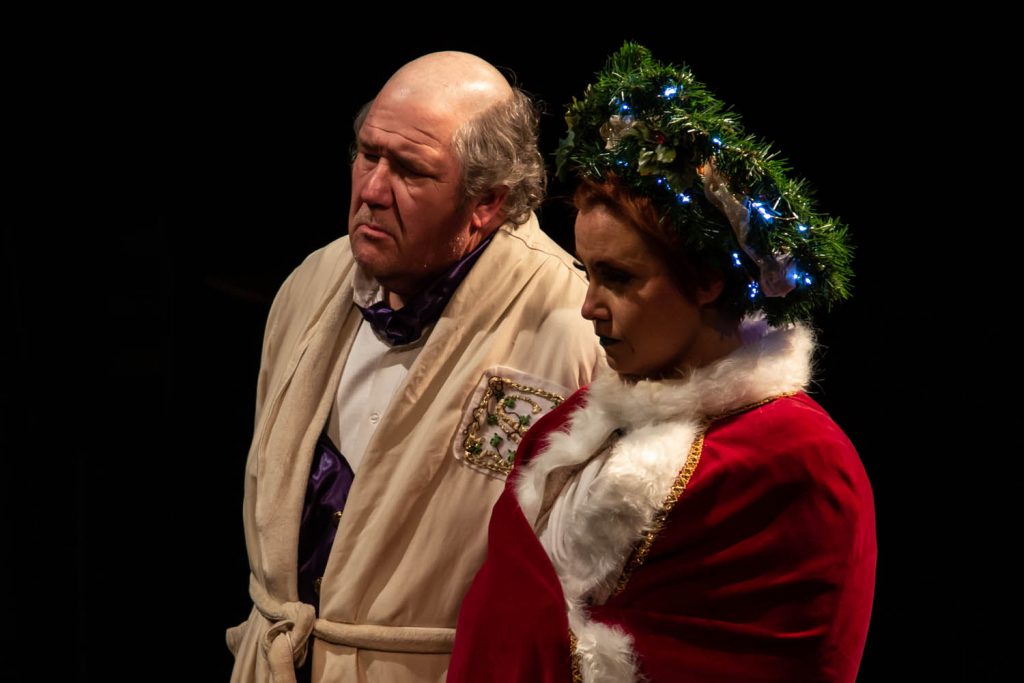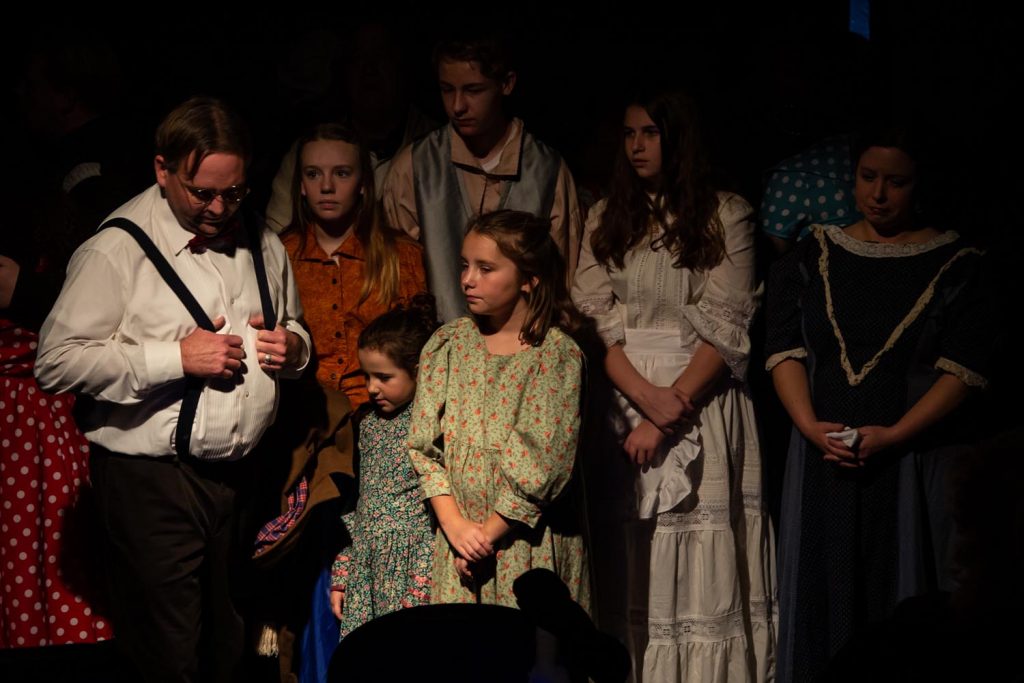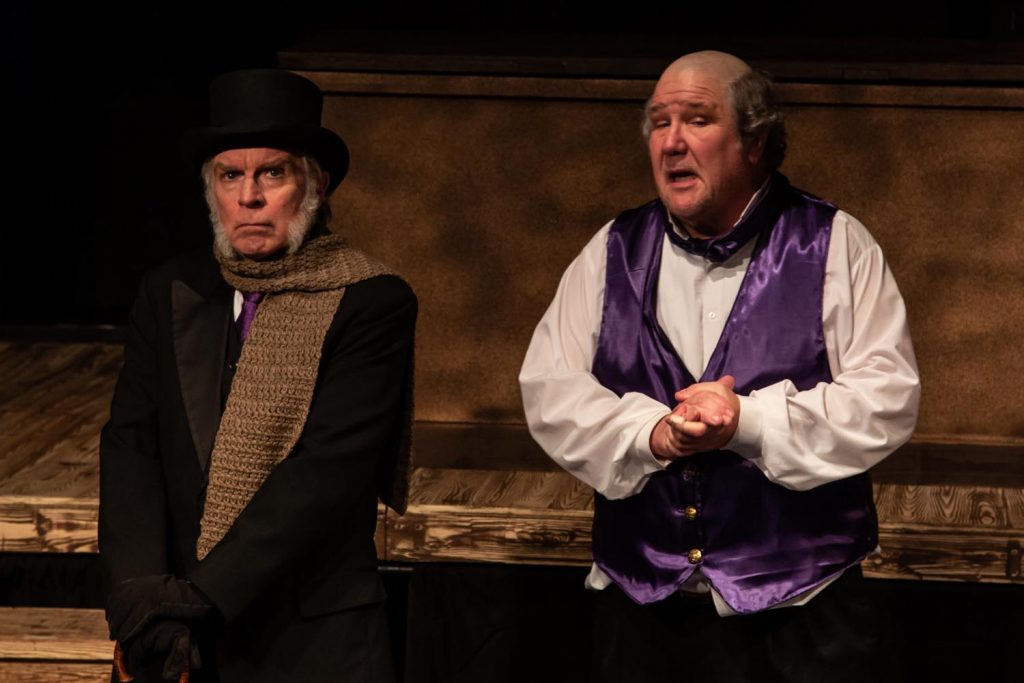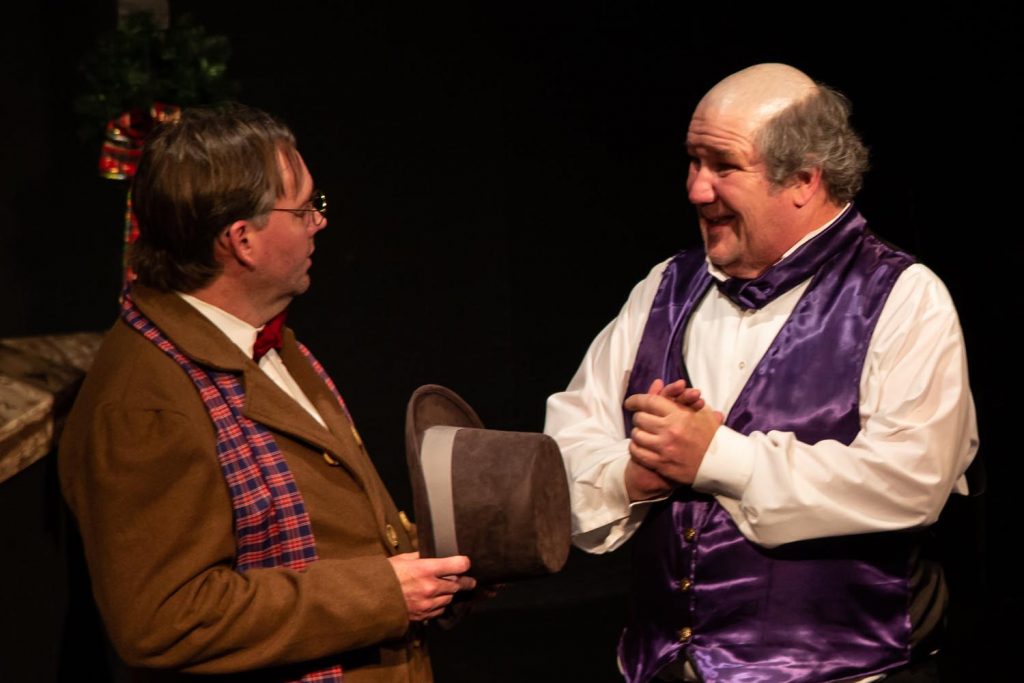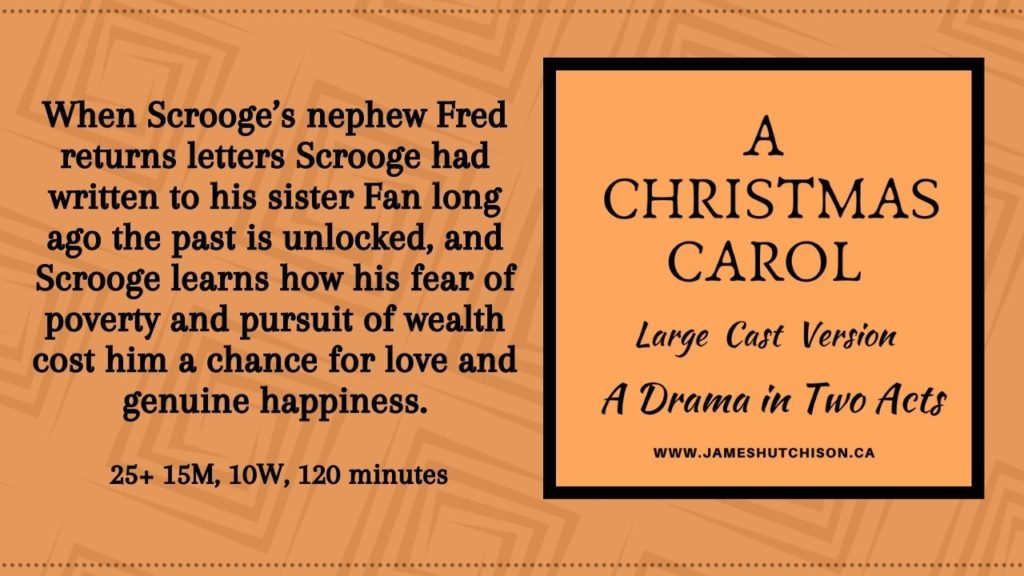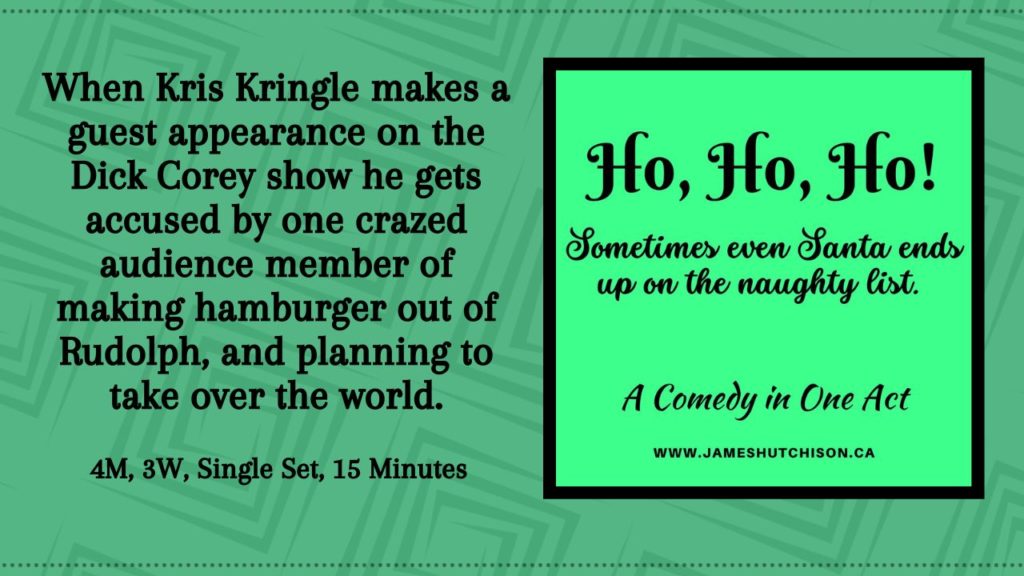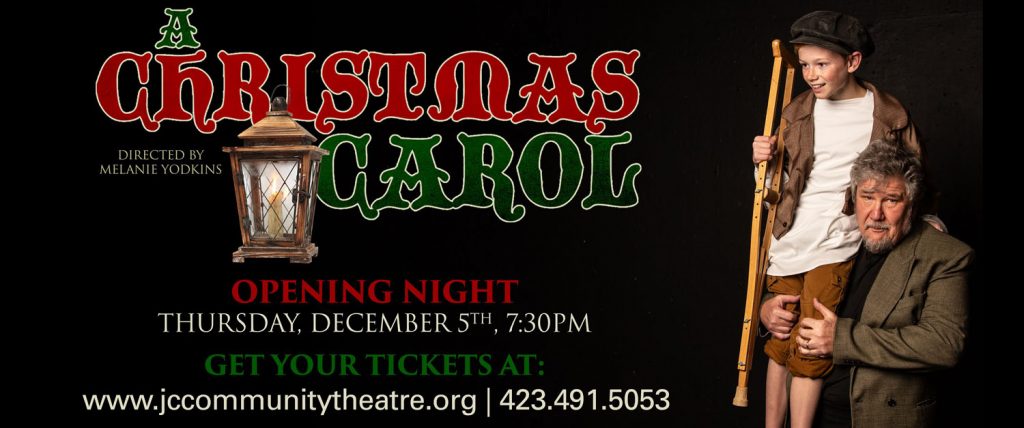
Scrooge was in love – once long ago. This must be clearly understood or nothing wonderful can come of the tale you are about to hear.
That’s not exactly how A Christmas Carol begins. No, it begins with Marley was dead and looooong buried. Marley was Scrooge’s business partner and only friend in the world, but Scrooge had once been in love. That is true. He had loved Belle. They were engaged. His life could have been very different and that’s what makes Scrooge such a tragic and sympathetic character.
This Christmas, 176 years after the story was first published, the Johnson City Community Theatre is producing my big cast version of a Christmas Carol from Thursday, December 5th to Saturday, December 22nd. The production is being directed by Melanie Yodkins and stars Tom Sizemore as Ebenezer Scrooge. I connected with Melanie and Tom early in November to talk with them about the Johnson City Community Theatre and the production of the play.
JAMES HUTCHISON
Tell me a little bit about the Johnson City Community Theatre.

MELANIE YODKINS
Johnson City Community Theatre is the longest consecutively running community theatre in the entire state of Tennessee and next year will be our 108th season. The patrons have always kept it going. The people who love to perform. The people who love to be in the productions.
We have an archive going all the way back 108 years with photographs and production brochures and memorabilia. We’ve got folks who have been here forever. Generation after generation.
That’s really the joy of community theatre. Family is really the biggest piece. My husband Jason and my son Andrew are in the play. My son is a year old and cute as the dickens.
TOM SIZEMORE
No pun intended.
MELANIE
No pun intended. I literally only have them walking across the stage and they light the lamps in the street scenes. Andrew is definitely not old enough to handle much more than that. My husband and I actually met on that stage six years ago. We met and fell in love. We were doing a Christmas play, and we started dating on December 18th. We were married less than two years later. And just before our third wedding anniversary, Andrew was born and now he gets to perform on the same stage.
JAMES
But, isn’t that nice. We were talking about history and so when your son is twenty years old there will be a production photo of him and his dad in the play. So, what do you think theatre provides a community?
MELANIE
I think people crave story. I think they crave that connection with literature with the past with people with opposing viewpoints, and I think theatre allows those doors to just be blown wide open, to allow for people to see and to experience things that otherwise they would not.
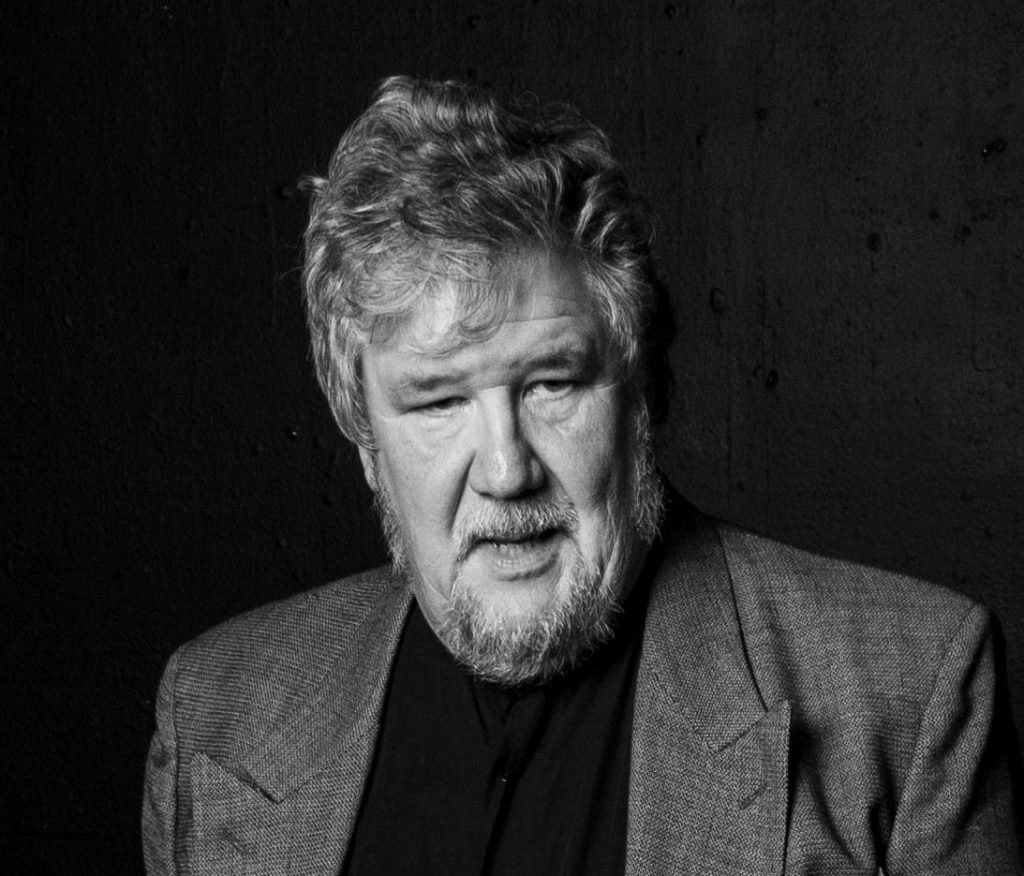
TOM
And with the times we’re living in people can be transported to, in this case, Victorian England and so it’s a way for them to feel better and feel good about things that maybe in other areas or other walks of life they’re not feeling so good about. And I think it’s a wonderful way for children to develop self-esteem, self-image and confidence.
JAMES
How young were you when you got on the stage, Tom?
TOM
Well, I’ve been doing community theatre for about twenty years. But my parents always said that I was singing before I could talk. I’ve been singing my whole life and after college and having been in a few musical productions it just made sense for me to branch out and do some non-musicals as well.
JAMES
You’ve had a lot of vocal and musical training and I’m wondering when you’re doing a play like a Christmas Carol, which is not a musical, how does your vocal training impact your ability to portray a character?
TOM
Quite a bit, actually. There are moments in this play that are sublime – that really tug at the heartstrings – that are very tender – that are very touching. And so, from a vocal standpoint, and especially in a smaller, more intimate venue, which is what is here at the theatre in Johnson City I’m really trying to use different vocal techniques to bring out some tenderness – to bring out in this character, some vulnerability. Which I definitely think should be there. But at the same time when the spirits are aggravating me to death and wanting me to see things that I really don’t want to see and I don’t want to deal with – then my disapproval or my impatience with that whole situation comes out and I use a lot of vocal techniques to let them know that I’m not happy.
JAMES
So, Tom, you and Melanie are talking to me from a room in your home that is filled with Christmas Carol memorabilia. Clearly this story is a love and a passion for you.
TOM
It is. I told Melanie that this is a dream come true for me. I had played Marley in a previous production but to play the old miser is something I’ve always wanted to do. I grew up in the Washington DC area and it was a tradition for us to go to Ford’s Theatre, every Christmas and see their production of Christmas Carol. I’ve been fortunate because I’ve been able to meet Charles Dickens’ great-grandson and his great, great-grandson and to have been to Dickens’ home in London. When I was growing up the story was one that I just loved, and I’ve seen every version that I could find whether it was film or television or just in any media. And then I started collecting things that are related to that including a 1916 poster from a version of A Christmas Carol, and I actually have a silent movie and was produced by Thomas Edison.
JAMES
You’ve been prepping for this role for a long time.
TOM
I have.
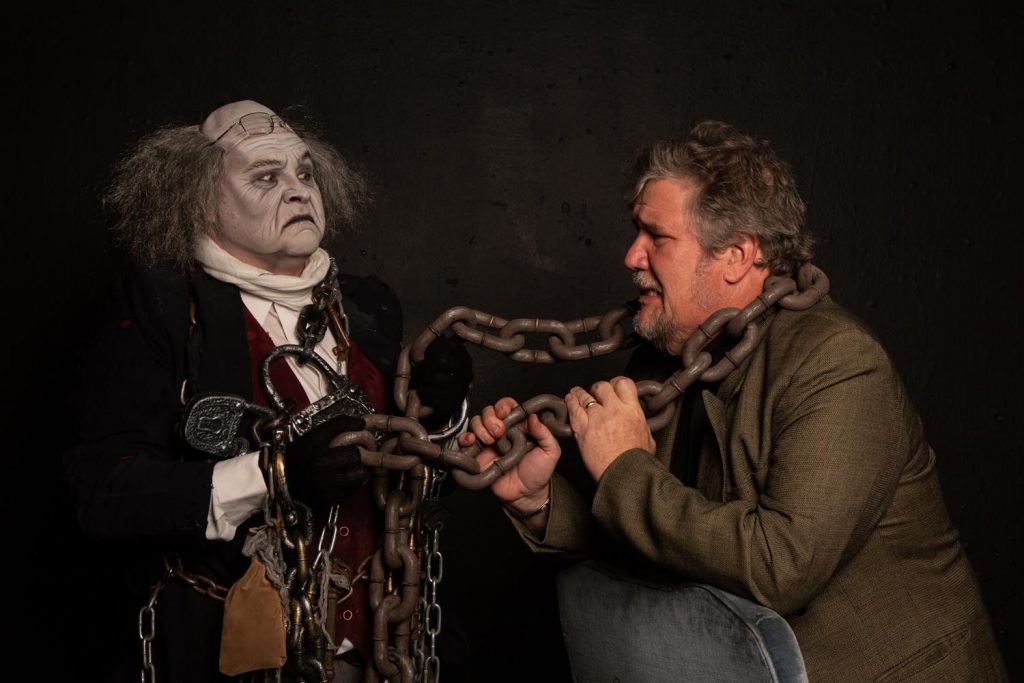
JAMES
Melanie, I’m curious to know what resonated with you about my particular adaptation?
MELANIE
I read over fifty scripts and when I was reading through your script what it provided that no other script did was the ability to add my own creative flair to the story. And you had already written in several things that I wanted to do. For example, the part where Christmas Future comes out of the box and wraps all of the chains around Scrooge and then Scrooge ends up in the box and I wanted to do that very same thing and it was already written in your script.
And I was reading it myself but I decided I needed more voices so I could just sit and listen to the voices telling the story so I could visualize it. So, I put together a table reading with some folks who I trusted and I just sat there and I listened. And it just resonated so deeply with me. And it was a no brainer. I was like, “This is the one I want. This is the one I want to do.”
JAMES
So, tell me a little bit then about some of the things you’re doing in terms of design elements for your vision of the story?
MELANIE
Andrew Whitman is our set designer. He’s actually one of my students from eons ago. He was in high school doing a summer arts program and I was one of the teachers running the program. And he has since graduated from college and worked at the Barter Theatre, the equity theatre up in Virginia. And so, I asked him to pitch me some ideas after reading the script himself. And one of the things that he brought up was that he wanted the desk to also be Scrooges bed and Scrooges tomb.
So, we’ve built this gargantuan desk. It’s big enough that Tom can fit on top of it. And Tom can also fit inside of it with another person. We really wanted to play on that concept that the desk represented Scrooges Empire. It really is his idol. It really is his life and then to have him buried in it or entombed in it we thought would be a really poignant way to drive home that little nugget. And then we also have it on a three-foot-high platform. So, I’ve got two staircases that kind of move around this platform so you can create different spaces based on where the stairs are so for example when they’re both in front of it that’s when it’s Scrooge and Marley’s. So, it’s this homage to the great and powerful desk and Scrooge.
JAMES
One of the most challenging parts for me to write was the scene where Belle leaves Scrooge. I rewrote that a number of times because I needed to make it very clear what was going on there. I love that the older Scrooge watching the scene tells his younger self to “Go after her you fool.” That’s a wonderful moment but we wouldn’t feel anything unless we had the earlier scenes where we see some real tenderness and love between them.
MELANIE
You have to feel something for Scrooge, or it wouldn’t matter. It’s not enough to know that he is who he is. You have to understand how he got to be the way he is. And you have to understand what he sacrificed to become that person without even realizing that he was sacrificing it.
You know, the first time the actors playing young Scrooge and Belle went through that scene their levels just kept going up and up and up until they were actually yelling at each other. And all of a sudden she says, “Are you not miserable?” And he just looks at her and there’s this dead silence there for a minute and you just sit there holding your breath. And, then she goes on to say, “I have no choice but to release you. And, I hope you’re happy in the life that you’ve chosen instead of a life with me and I will always mourn the life that we could have had.” And she leaves him standing there absolutely shredded.
JAMES
Tom, what are your thoughts about Scrooge’s journey to redemption?
TOM
By the end of the play he needs to show how deeply affected he is by what he has been shown, but he resists and fights it tooth and nail and he tries to make excuses. And one of the other ways I’ve looked at it is Scrooge is a businessman and being a businessman he’s smooth and persuasive and he’s used to getting his own way and when he doesn’t that’s not a feeling that he is very comfortable with. But I also think there is a humourous aspect to it as well. For instance, when the Ghost of Jacob Marley asks him, “Do you believe in me or not?” Melanie has blocked the scene so that Marley is only about an inch from my face. And then Scrooge says, “No, I do not.”
JAMES
Why do you think A Christmas Carol resonates today so many years after it was originally written?
MELANIE
I think there is a little bit of Scrooge in every single person. To the extent that we get wrapped up in me, me, me, my, my, my, this is my world, this is what I’m doing. These are my goals. This is my focus. And then all of a sudden, Christmas comes around and we’re like, oh, hey, we can give ten dollars to a charity or we can collect food for the food bank or we can give gifts to people that they’re going to love. But then you still have people who don’t even want to do that.
I love the fact that this truly is a story of redemption which makes a really beautiful connection to Christmas too. Because if we think about the biblical side of it Christmas represents the time of Christ’s birth and the beginning of redemption and you kind of have a really nice parallel with Scrooges own redemption and the redemption that we find in Christ, which is much of what literature of the time alluded to back when A Christmas Carol was written. People weren’t writing Bible stories, but they were utilizing the same moral concepts from Scripture and putting it into story form.
And so it touches people’s hearts in such a way that doesn’t make them feel like we’re shoving Jesus down their throat. We’re touching people’s hearts on a totally different level and reminding people about charity and compassion and those are the things that should really be our business in life. That’s why we’re here. We’re here for all of humanity. It’s all our responsibility. And all of those elements work together to create a reason why so many people love this story.
JAMES
Tom, how about you?
TOM
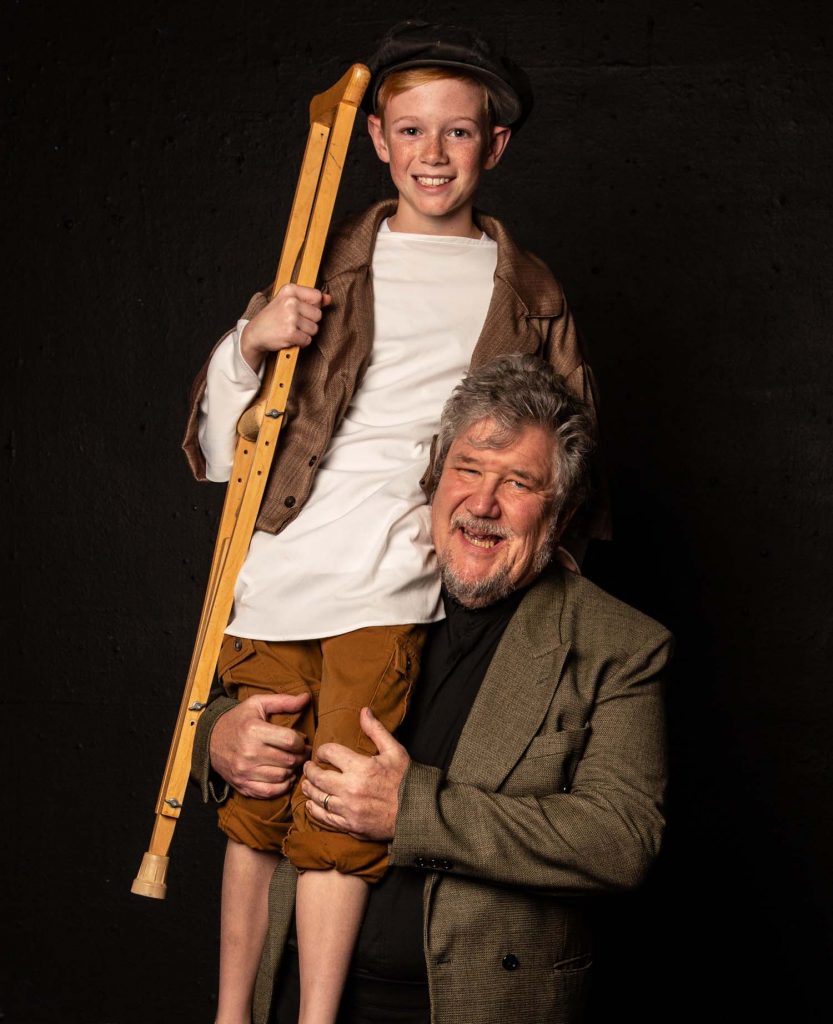
If Scrooge can change, we all can change, but that process is not easy. And in Scrooge’s case I think there’s a reason Dickens wrote it as a ghost story. It’s significant to me that in order for this process to begin, Scrooge has to be scared to the point that his legs are shaking. He’s never experienced anything like this before in this life. So, in order for change to occur sometimes, we have to experience something that we would never expect or something out of this world has to happen in order for a person to change. And because of all of the relationships, the family bonds, the love of the Cratchits the story is timeless. We probably all have, truth be known, family members that we are reminded of from the story.
JAMES
Why should folks come out and see Johnson City theatre’s production of A Christmas Carol?
MELANIE
Because the artistic concept of how we’re presenting this play, while telling an absolutely fabulous story, isn’t like anything I’ve ever seen. It’s incredibly original. And we have incredible actors. After Tom auditioned, I needed to find a Marley that matched the epitome of the Scrooge that Tom brought to his audition. And the young man who is playing Marley, absolutely, bar none just blew me out of the water. It brings such a high calibre of performance quality to this production that people need to come and see the hard work, the dedication and the heart of storytelling that is found only on this stage this season.
TOM
I think it’s definitely an ensemble cast so that each person brings something to their role and their character. People will be talking about it and raving about it. And it goes without saying that I’m just honoured and privileged to be part of it.
Cast A Christmas Carol
Olivia Ares, Gavin Arsenault, Larry Bunton, Asher Church, Lorelai Church, Sam Church, Adam Derrick, Tony DeVault, Camden Downes, Hudson Downes, Cierra Fannon, Jada Greenlee, Shanna Greenlee, Danielle Hammonds, Andrew Headen, Jason Headen, Linden Hillhouse, E.C. Huff, Landon Kell, Audrey Kuykendall, Magee Little, Jamie Lombardi, Richard Lura, McKenna Marr, Tom Sizemore, Nathaniel Oaks, Evangeline Perreault, Matthew Pickle, Raelyn Price, Elizabeth Renfro, Saqqara Scott, Derek Smithpeters, Alice Tester, Lucy Tester, Daniel Tester

